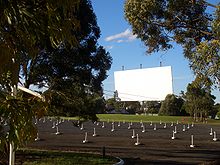COVID-19/Workflow Transformation/Culture and Music
Epidemiological restrictions have an impact in the cultural events, due to the fact that the community experience of a musical or cultural event is part of such an event. From an epidemiological point of view, however, events are not possible in a way before COVID-19. For example, if a live event is broadcasted from another city to a cinema, the staff members of the cultural event may not be in the same room, but at least the cultural event is a shared experience with others. During a drive-in event the interaction between the artist and the audience must be transformed, because it ist one asset from which a live event benefits in comparison of one-directional streaming event. The learning resource supports in the consideration of cultural and music events under epidemiological constraints. For such a transformation process either a different added value for the joint experience in the audience must be created, which replaces the joint experience with many people on the event. Analyze the following example and consider what other options for interaction can be offered to visitors to a music or cultural event:



Target Group
editThe target group is:
- Organizers of Local and Regional Events,
- Small and medium-sized Enterprises, that do not have a financial support during COVID-19
which must reorganize themselves for transforming the events under epidemiological constraints.
Learning Objective
edit- What are aspects that must be considered by organizers of local and regional events if they want to transform their event by an organisational workflow that allows participation under epidemiological constraints.
- What are options to support local and regional reate local and regional support infrastructure that allow the supply of food and beverages?
- How can these events be transformed under consideration of the Sustainable Developement Goals? Can people come to a life event by bicycle and have to respect the same spatial distance to other people in the audience or does it create inacceptable epidemiological risk.
- (Inside/Outside Events) What is the epidemiological difference between events
- performed outside,
- performed inside
- with the same spatial distance between people in the audience? Discuss the different approaches! Aerosols and crowded places. Analyse the current epidemiological knowledge about infections.
- (Online Rehearsal) Explore the OpenSource software Jamulus to jam online and allow rehearsal during Lock Down. This learning resource follows the Open Community Approach so that the principles of approach can be experienced with an open access to the software resources and the ability to adapt the source to your local needs and requirements with the option of a sustainable application for this learning resource (see also Virtual Band).
Drive-in Cinema/Drive-in Theatre Live-Event
editA drive-in cinema/car theatre can be used as an alternative to a cinema or theatre hall for an event. A live event with an artist also lives from the interaction of the artist with the audience.
- How can you create an interaction between artist and audience in a drive-in cinema/autotheater? (Applause, interjections, answers to questions from the artists to the audience?)
- Explain why the epidemiological framework conditions can be better taken into account in a drive-in cinema/autotheatre than in a classical cinema or theatre visit.
- How can you still create a community experience?
- How can the artist also use webcams to perceive the facial expressions in the audience and react to them? Use interaction with a few webcams may be staff member recording feedback from the audience and that can be provided to the artist and the artist may decide to respond to that on the video screen.
- What are the advantages and disadvantages of webcams from inside the vehicles and do the event visitors want this interaction with the artist? Can the people in the audience decide freely whether they want to interact with the artist or not? How does the interaction between the artist and the audience appear on monitors visible to all?
- What has to be considered technically at such an event and what do the artists have to learn to interact with the audience in this new way?
- Broadcast the audio through car by a specific radio frequenz to the audience. Assure that the audio quality is good for the audience. What are options for feedback for the audience in a Drive-In situation (equivalent to applause)?
Music events
edit- (Streaming and Interaction with Artist) A streamed music event must differ in the experience from a live event and therefore these events require an added value for the audience to just streaming the video at home.
- (Drive-in Theater) Transfer the transformation process from a drive-in cinema/car theatre to a music event where the audience is connected to the audience via video conferencing!
- (Contact Artists/Audience) Allow as organizer the contact after and/or before the music event with the artists via videoconference. How can this contact of the audience with the artists via video conference create a special experience for the event guests. Would this be an added value that could also secure a financial livelihood for the artists? Do you transfer the classic event procedures to digital processes? How can the sound quality of the music event be ensured (bandwidth)? Do you think this is a possible path of epidemiological transformation and what should be taken into account? To what extent are the artists willing to allow this personal contact with the event guests in a video conference?
Video Tutorials
editOpen Source Software
editSee also
editReferences
edit- ↑ Installation of Jamulus (2020) by AudioGeek11 - Youtube: Jam music online with Jamulus - URL: https://www.youtube.com/watch?v=2TqehIebsm4&list=PLhv89UEp26gyfCtj4z9aNw0nEMMrPh6ys (accessed 2020/08/02)
- ↑ Online rehearsals with Jamulus (2020) by Vierimpuls - Youtube URL: https://www.youtube.com/watch?v=lB4ZxDb9vnU (accessed 2020/08/02)
- ↑ (2020) by David Addis URL: https://www.youtube.com/watch?v=6qcE-zDbW7Q (accessed 2020/08/02)
- ↑ Jamulus - Online Jam Software (2020) Open Source Software - URL: http://llcon.sourceforge.net/ (accessed 2020/08/02)